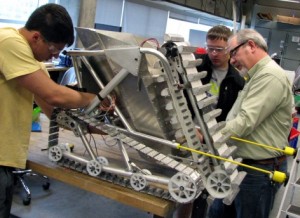
Even though other teams have started to copy some of their winning ideas, the student-engineers of Cyclone Space Mining feel good about defending last year’s NASA championship.
“That’s all right,” David Peiffer, a junior in industrial engineering from Marion and the president of Iowa State’s robotic mining club, said of the copycat teams. “We’ve had issues in the past and we’ve learned from them. We’ve improved.”
Iowa State’s team will show off its latest improvements May 19-23 during the NASA Robotic Mining Competition at the Kennedy Space Center Visitor Complex in Florida. The annual competition challenges university teams to design and build robots capable of maneuvering across a simulated Martian landscape while digging, collecting and dumping loads of gritty, dusty soil.
Last year, Iowa State’s team brought home the grand prize, the Joe Kosmo Award for Excellence.
This year’s robot should be able to beat last year’s champ, said Brian Jend, a May graduate in mechanical engineering from Fitchburg, Wisconsin, and a project director for the space mining team.
That’s because the new machine is lighter, more functional and could even operate on its own. Peiffer and Jend said the improvements are in the details: lighter plastic for the machine’s 20 wheels, a track system connected by wires instead of belts, a better angle for the aluminum scoops that dig up the soil, a collection bin that’s easier to fill and dump.
And then there’s autonomous operation, a major goal for the team that’s worth a big bonus of 500 points.
Last year’s team came close, but had to fall back to remote control when the robot settled on a slope, tilting the machine and throwing its laser-guided control system over its target.
Jend said the team’s solution is an oscillating laser that should find its target, even if the robot hits a big slope.
“If you can run entirely autonomously and collect the minimum amount of material, you’d almost certainly win,” Peiffer said.
Jim Heise, a senior lecturer in mechanical engineering and the team’s faculty advisor, said the NASA contest is a great way for students to learn some engineering and get noticed by companies.
“They are a highly motivated bunch of students, from freshmen all the way to seniors,” he said. “They love working with NASA. And the level of hands-on work makes them excellent engineers – a lot of companies seek them out for internships and full-time jobs.”
The team’s experience and recent success has certainly created some confidence around the team’s workshop. The student-engineers aren’t really worried about copycats or defending last year’s title:
“It’s a different contest every year,” Jend said. “There might be pressure if I wasn’t confident about what we’ve built.”
The story first appeared here.